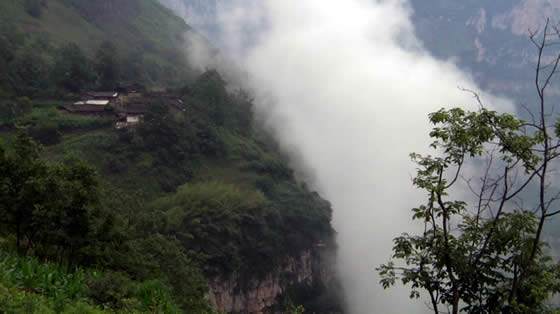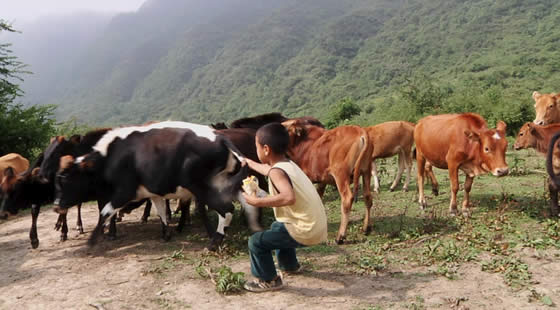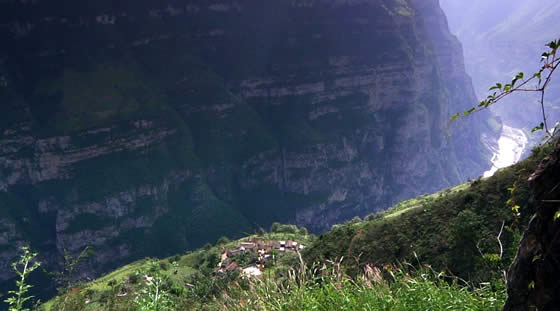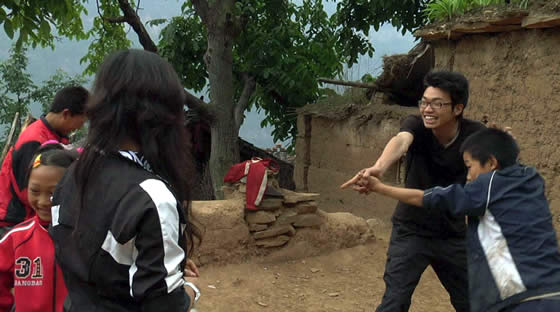 ON THE RIM OF THE SKY directed by Xu Hongjie is the story of a substitute Teacher in the Gulu Primary School, on the cliff in Sichuan, China, for over 26 years SHEN QIJUN has always wanted to become a real teacher till one day a young man, BAO TANGTAO, who calls himself “Don Quixote” arrived at the village…
ON THE RIM OF THE SKY directed by Xu Hongjie is the story of a substitute Teacher in the Gulu Primary School, on the cliff in Sichuan, China, for over 26 years SHEN QIJUN has always wanted to become a real teacher till one day a young man, BAO TANGTAO, who calls himself “Don Quixote” arrived at the village…
Bijan Tehrani: How did you come up with the idea of making ON THE RIM OF THE SKY? Please tell us about pre-production stage of ON THE RIM OF THE SKY.
Xu Hongjie: I read a report about Gulu Village, the substitute teacher Shen Qijun and the volunteer Bao Tangtao on the internet at the end of 2008. The two characters from two different worlds and the cliffs interested me at once, I immediately made the decision to go to the mountains and make a documentary. But at that time, I had to take a few exams for my studies at the University of Cologne in Germany (After the first shooting I dropped out of university.) After the exams in February 2009 I began with the research work. The more I researched, the more I felt that I should go to the mountains as early as possible, because I couldn’t know how long the Volunteer Bao would stay there. But I knew he would stay at least until the end of the school half year. So within three months I finished writing a treatment and a shooting plan, building a team and finally I got important support: A friend loaned me money so that I was able to buy the equipment for the shooting. On 4 June 2009 we started shooting.
BT: How challenging was it to get to the locations for making the film?
XH: It was really hard to make a film there: the mountain path with strong UV, very slippery in the rain; so many mosquitoes, so many flies… they are not as beautiful as the landscape. We couldn’t shoot much during school time, because we were told to disturb the school as little as possible. We always had to figure out a nimble shooting plan when we got some new information or we met a new situation. The most dangerous was the shooting at the heaven ladders: the path to the heaven ladder is just about 30-40cm wide, next to the path is a few hundred meters gaping abyss. The heaven ladder was put on the rock without any fixing, really, except Bao, none of our team wanted to climb the most dangerous heaven ladder ever again. After that shoot I caught a cold due to the strong wind and lost my voice for few days…
BT: ON THE RIM OF THE SKY has a unique and stunning visual style, how did you come up with this style?
Did you have a script for making the film? It has the structure of fiction.
XH: Thanks for the compliment! While I was studying I made four short/middle length documentary films. I was satisfied with two of them. They were my exercises and experiments, they were also not in a fixed style. During that time, I came up with an idea: I wanted to try and tell a documentary story in the style or structure of a  fiction film. I thought, a lot of good fiction films are based on a real story, there shouldn’t be a strict border between fiction form and documentary form. With this idea in mind and the researched material, I wrote a treatment for the documentary “On the Rim of the Sky”. Sure, it was a challenge for me, especially as some information about the past had to be included in the film. But in general, you can analyze and imagine the development of the real story according to the existing conflicts. For example, why do they have such conflicts, because of their different backgrounds or their characters? What are their “wants” and “needs”? What about the inside situation and the outside situation? What is the fate of teacher Shen, the future of the school and the village? How long will the volunteers stay? And what do I want to say with this film? This analysis was really useful when I wrote the treatment and it was also a guide for the shooting. But what actually happened in the village Gulu was stronger and much more rapid than I imagined.
fiction film. I thought, a lot of good fiction films are based on a real story, there shouldn’t be a strict border between fiction form and documentary form. With this idea in mind and the researched material, I wrote a treatment for the documentary “On the Rim of the Sky”. Sure, it was a challenge for me, especially as some information about the past had to be included in the film. But in general, you can analyze and imagine the development of the real story according to the existing conflicts. For example, why do they have such conflicts, because of their different backgrounds or their characters? What are their “wants” and “needs”? What about the inside situation and the outside situation? What is the fate of teacher Shen, the future of the school and the village? How long will the volunteers stay? And what do I want to say with this film? This analysis was really useful when I wrote the treatment and it was also a guide for the shooting. But what actually happened in the village Gulu was stronger and much more rapid than I imagined.
BT: The villagers are very comfortable on camera, how did you work with them?
XH: The villagers called me “Journalist Xu”, they had seen many journalists before I came there. But like no other journalists, who stayed there normally for one day two days or came there one time two times, this “Journalist Xu” went there four times and stayed on the mountain for 60 days all together. At the beginning they were curious because of my camera, but later it was very normal for them when we were filming somewhere every day. They are not complicated. I tried to understand them including teacher Shen and teacher Bao. I always thought: If I was in their situation, I might do the same. So, being able to understand them made it easier to get into contact with them.
BT: There is a poetic approach to the locations and people in ON THE RIM OF THE SKY, was it intentional?
XH: I like this question. The poetic approach was intentional. As I wrote the outline for my first fiction film idea with the title “The tree shadows in the wind” in 2007, I told myself: whether it is a documentary or a fiction film, you should always try to make them this way: poetic, humorous and dramatic. “Poetic and humorous” in the film means to me: we love life in this world even if it is often confusing and dramatic.
BT: What is your next project?
XH: There have been a few ideas for documentary and fiction films in my head for years now. I need some time to complete the idea to “The tree shadows in the wind”, at the same time I intend to start writing a script about a historic person, but the next shooting will soon take place in Germany for a documentary series idea with the title “Warum” (“Why” in English). I’ll try to do a good job.

